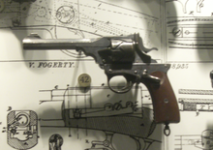The entire upper recoiled on the lower frame, advancing the cylinder and cocking the hammer at the same time. Technically, it was recoil operated, not blowback.
I am not sure how you could make something more complicated and utterly useless,
Complicated? yes. But not any more useless than any other revolver.
it's still a cylindrical action so there is no reloading advantage,
Advantage over what? its a top break revolver, with all the advantages and disadvantages of that design.
Advantages over a standard semi auto? No separate magazine. No issues feeding from a magazine. No needing to extract each round individually and feed in another for each shot. Disadvantages? 6 shot capacity, slower to reload than a standard semi auto (using preloaded magazines).
Faster to reload than a solid frame SA revolver. Reportedly very sensitive to what is today called "limp wristing". Made in .45 (.455 Webley) and .38 calibers.
one other advantage, lighter trigger pull for each shot than the DA trigger pull of regular DA revolvers.
1901,,, people were still figuring things out back then, and many different designs were tried. The first Luger didn't arrive until 1902. And the watershed design of the 1911 wasn't around until 1911, a full decade later.
I doubt few Webley-Fosberrys saw really hard use, there are no real reports about them being exceptionally fragile. Over complicated, and likely to break easily is always mentioned when talking about them, but no one ever has any reports of them actually breaking in any kind of significant numbers.
it was one of those ideas that flourished at the turn of the century, but turned out to not be an overall advantage, despite some advantages in some areas. An evolutionary dead end in handgun design.
But not the worst design ever, nor totally useless.
if you want to see some other dead ends that ought to have been good ideas, but turned out not to be, look up the Dardick revolver (and its "tround" ammunition) and the Gyrojet pistol.
Compared to the Webley-Fosberry, those two are fairly recent..
There is a certain spirit of invention (especially in the years before and after 1900) that says "how do you know it won't work unless you try it?"
So, lots of things got tried. Today, we have a much, much larger store of knowledge about what works, and what doesn't, partially due to those who did try this and that, to find out what worked well, and what didn't.
Probably the biggest mystery is that Webley made about 5000 of them over 20 years.
No mystery there. They were British. The gun did work. There was the makers prestige involved. They were British. They had money invested in the design. While it didn't set popularity records, the guns did work. And they were British....


